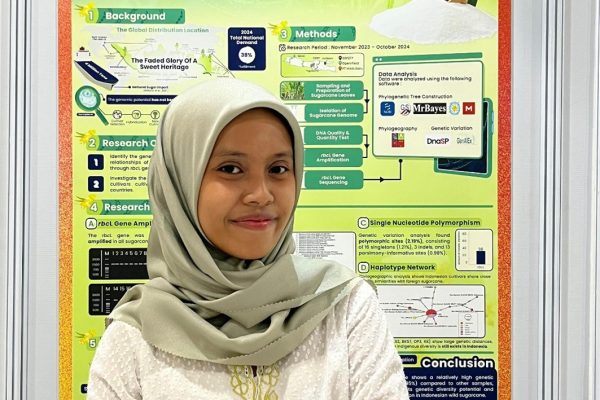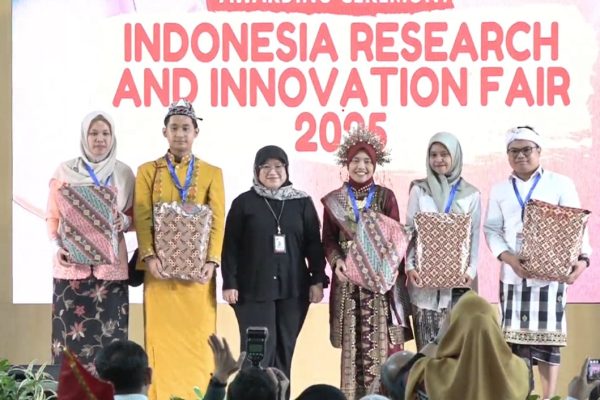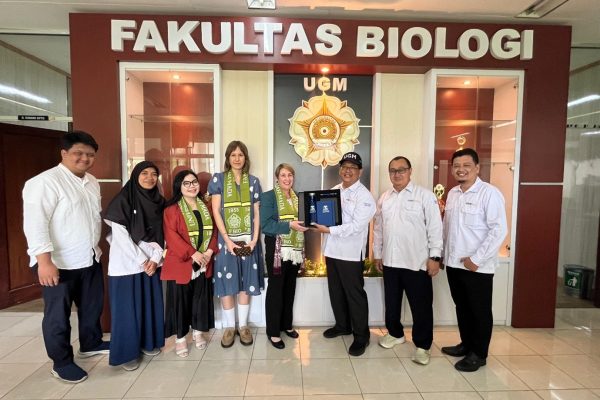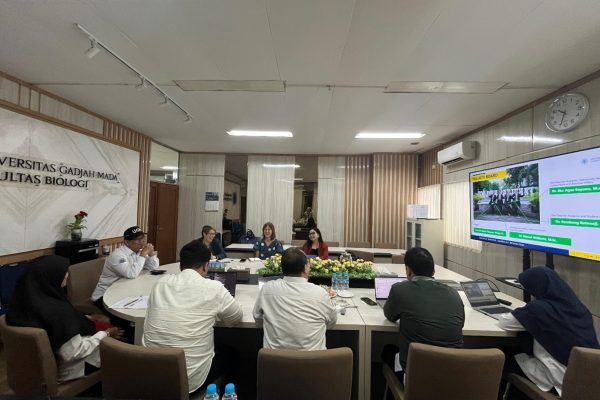SDG 17 : Build Partnerships for the Goals
Yogyakarta, 19 September 2025 – For the first time, the Faculty of Biology, Universitas Gadjah Mada (UGM), staged the spectacular Biothoprak 2025 art performance as part of the celebration of its 14th Lustrum and 70th Anniversary. Held in front of Al-Hayat Mosque at the Faculty of Biology, the performance brought to life the classic folklore “Ande-Ande Lumuten”, creatively adapted with modern elements and rich moral values.
Biothoprak is a traditional Indonesian theatrical art, and this year the Faculty of Biology UGM successfully presented a remarkable collaboration between lecturers, students, staff, and alumni. The performance became a platform for intergenerational togetherness within the academic community, reflecting the spirit of kinship that has long been a hallmark of the Faculty. “Through Biothoprak, we aim not only to provide entertainment but also to convey the importance of culture, unity, and the noble values of our nation. This year, we chose the play Ande-Ande Lumuten, which carries meaningful messages of honesty, loyalty, and kindness,” said Prof. Dr. Budi S. Daryono, M.Agr.Sc., Dean of the Faculty of Biology UGM.
The Ande-Ande Lumuten performance was enhanced with modern stage design, creative costumes, and multimedia technology, offering the audience a refreshing theatrical experience. The enthusiasm of the audience was evident, with more than 1.000 onsite attendees, including lecturers and their families, staff members with their families, retirees, alumni, students, and the general public. In addition, hundreds of viewers joined online via the Faculty of Biology’s YouTube channel. The celebration was further enlivened with exciting door prizes and traditional Jogja culinary treats, including angkringan dishes and live-cooked noodles.
As part of the 70th Anniversary of the Faculty of Biology UGM, Biothoprak 2025 was not only a cultural performance but also a realization of the values of the Sustainable Development Goals (SDGs), particularly: SDG 4: Quality Education – through collaborative, intergenerational learning, SDG 11: Sustainable Cities and Communities – by preserving and revitalizing local culture, and SDG 17: Partnerships for the Goals – through synergy between the academic community, alumni, and society.
The event was warmly received by the academic community, alumni, and the wider public, serving as a vibrant closing highlight of the 14th Lustrum and 70th Anniversary of the Faculty of Biology UGM, held under the overarching theme “Biology for Environment and Humanity.”
Yogyakarta, 18 September 2025 – The Faculty of Biology, Universitas Gadjah Mada (UGM), held the peak ceremony of its 14th Lustrum and 70th Anniversary on Thursday (18/9) at the Tropical Biology Auditorium. Carrying the theme “Biology for Environment and Humanity”, the event reaffirmed the Faculty’s commitment to advancing environmental sustainability and improving the quality of human life, both nationally and globally. The ceremony was also broadcast live through the Faculty of Biology UGM’s YouTube channel, enabling wider public participation.
The Open Senate Meeting was attended virtually by the Minister of Higher Education, Science, and Technology of the Republic of Indonesia, Prof. Brian Yuliarto, S.T., M.Eng., Ph.D., who emphasized the importance of collaborative tropical biology research to address future challenges in food, energy, and the environment. The Rector of UGM, Prof. dr. Ova Emilia, M.Med.Ed., Sp.OG(K), Ph.D., expressed her appreciation for the Faculty’s achievements in generating impactful innovations in tropical biology. She further highlighted UGM’s position, through the Faculty of Biology, as a National and International Center of Excellence in Tropical Biology.
The keynote scientific lecture was delivered by Drs. Heri Susanto, S.Si., M.M., Managing Director of Rentokil Initial (Indonesia, Sri Lanka & Maldives), with a presentation entitled “The Role and Application of Biology in the Pest Management Industry in Indonesia and the World”. He emphasized the critical role of biology in integrated pest management to support food security, public health, and the sustainability of environmentally conscious industries.
Meanwhile, the Dean of the Faculty of Biology UGM, Prof. Dr. Budi S. Daryono, M.Agr.Sc., presented the Faculty’s accomplishments over the past five years, including the strengthening of tropical biotechnology research, the development of international curricula, and the contributions of alumni across various sectors. He also announced the soft launching of the Bio Medic Center building plan, envisioned as a new center of excellence for tropical biodiversity-based biomedical research and services.
The Open Senate Meeting served as the main agenda of a series of Lustrum XIV and 70th Anniversary activities that had been held since May 2025. These included a Fun Walk, Book Review and Blood Donation Drive, National Seminar on Tropical Biology, International Summer Course, Alumni Gathering, and the BioToprak Creative Stage. All activities were designed to strengthen the networks among academics, alumni, and partners, while reinforcing the Faculty’s role as a leading center for tropical biology at both the national and international levels.
The event also featured the signing of memorandums of understanding with PT. Biogen, the Marine and Fisheries Office of the Special Region of Yogyakarta, and St. Augustine Catholic University, focusing on collaboration in education, research, and community service.
“The theme Biology for Environment and Humanity serves as a reminder that innovations in biology must always be directed toward sustainable solutions for the planet and the welfare of humankind,” remarked Prof. Budi S. Daryono.
Indonesia Research and Innovation Fair (IRIFair) 2025 is a scientific competition for undergraduate and master’s students showcasing their thesis research. This event represents the commitment of the National Research and Innovation Agency (BRIN) to discover young research talents from higher education. The fair aims to improve both the quality and quantity of Indonesia’s research and innovation talents through scouting missions and comprehensive, sustainable, and innovative mentoring programs. This year, IRIFair 2025 was held on September 9–10 at the Polytechnic Institute of Nuclear Technology, coinciding with its 40th Dies Natalis celebration.
In this prestigious event, Tiara Putria Judith, a Fast-Track Master’s student at the Faculty of Biology, Universitas Gadjah Mada (class of 2024/2025), won the Favorite Poster Award in the Research Poster Competition (RPC). She also received a research grant to further develop her undergraduate thesis entitled “Genetic Variation and Phylogenetic Relationships of Sugarcane (Saccharum spp. hybrid) Based on the Chloroplast rbcL Gene”.
Tiara’s poster effectively optimized visual communication by combining impactful graphics with concise text, enabling her to present research findings clearly and attractively. Beyond serving as a medium of scientific communication, the poster also sparked engaging discussions with audiences, offering new insights into the advantages of DNA barcoding for overcoming the limitations of conventional identification methods in potential parental candidates for sugarcane hybridization in Indonesia.
This achievement underscores Tiara’s active role as a UGM Biology student in advancing innovations in life sciences and technology to address the challenges of sustainable agriculture. Her success is expected to become an early milestone for more innovative and impactful research explorations in the future.
Nara, 28 August 2025 — The Faculty of Biology, Universitas Gadjah Mada (UGM), continues to expand its academic and research collaboration at the international level through its participation in Bio Summer Camp 2025, organized by the Nara Institute of Science and Technology (NAIST), Japan, on 26–28 August 2025 at the NAIST Campus in Nara.
In this program, Prof. Dr. Bambang Retnoaji, M.Sc., Professor at the Faculty of Biology UGM, was invited as a guest reviewer by NAIST. His presence aimed to share expertise, provide academic feedback to students, and open opportunities for research exchange between UGM and NAIST.
Bio Summer Camp 2025 was attended by first- and second-year doctoral students, second-year master’s students, as well as lecturers and researchers from NAIST. The program focused on training scientific communication skills in English, student research presentations in the format of an international academic conference, and discussion forums that encouraged opportunities for cross-border research collaboration.
In addition to the main agenda, Prof. Bambang Retnoaji also met with Prof. Dr. Yasumasa Bessho of NAIST to discuss plans for developing a double degree program between NAIST and the Faculty of Biology UGM. This meeting is expected to serve as an initial step toward strengthening more structured academic cooperation in the future.
On this occasion, Prof. Bambang also met with several students and alumni of the Faculty of Biology UGM who are currently pursuing further studies at NAIST. The meeting further strengthened academic networks while providing support to UGM students pursuing careers on the international stage.
The participation of the Faculty of Biology UGM in Bio Summer Camp 2025 carries strategic significance in strengthening UGM’s reputation in the fields of biology and life sciences. Beyond enhancing the international capacity of students through global academic exposure, the program also paves the way for broader research and educational cooperation between Indonesia and Japan, including the potential establishment of a double degree program in the future. In line with its commitment to supporting the Sustainable Development Goals (SDGs), this initiative contributes to improving the quality of higher education (SDG 4), strengthening global partnerships (SDG 17), and advancing research that supports good health and well-being (SDGs).
Yogyakarta, 30 August 2025 — The Faculty of Biology, Universitas Gadjah Mada (UGM), and the School of Applied Sciences, University of the West of England (UWE), held an online meeting on Friday, 29 August 2025, to strengthen research and educational collaboration between the two institutions.

The meeting was attended by key representatives from both universities. From the Faculty of Biology UGM, participants included Dr. Eko Agus Suyono, M.App.Sc., Vice Dean for Research, Community Service, Collaboration, and Alumni Affairs; Dr. Nur Indah Septriani, M.Sc., Head of the Office of International Affairs (OIA); and Mukhlish Jamal Musa Holle, DPhil., lecturer at the Laboratory of Ecology and Conservation. From UWE, Dr. Adrian Crew, Head of the MRes Applied Sciences Program, joined the meeting along with one of his students, Tawny Bucks.
The agenda focused on updates regarding ongoing joint research projects and discussions on future opportunities for collaboration in both research and teaching. One of the key highlights was a project conducted in Simeuleu Island, Aceh, which emphasizes regenerative agriculture practices to support ecosystem sustainability and improve community well-being. The project is a collaborative effort between UGM and UWE, with direct involvement from Tawny Bucks and Syefrina Rosyida, an alumna of UGM’s Master Program in Biology.
Both institutions reaffirmed their commitment to continue the collaboration on an equal and sustainable basis. As an initial step, they agreed to develop a concept note that will serve as the foundation for further research projects in regenerative agriculture.
“This meeting marks an important momentum to strengthen research synergy between UGM and UWE, especially on global issues such as sustainable agriculture and conservation,” said Dr. Eko Agus Suyono.
The collaboration is expected not only to generate academic innovation but also to deliver real solutions to environmental and social challenges, particularly in remote areas such as Simeuleu. It also opens up wider opportunities for students and researchers from both institutions to engage in international academic activities. In line with the commitment to support the achievement of the Sustainable Development Goals (SDGs), this initiative contributes to enhancing food security (SDG 2), strengthening climate action (SDG 13), and promoting the sustainable protection of terrestrial ecosystems (SDG 15). Through this partnership, UGM and UWE are taking concrete steps to integrate academic research with global sustainable development objectives.
Pathogen Molecular Biology
Malaria and Vector Resistance
Pathobiology of Emerging and Vector-borne Diseases
Human Genetic Diversity and Diseases
Structural Biology and Cell Signaling
SDG 3 (Good Health and Well-being): advancing infectious disease research and developing genomics-based health solutions.
SDG 9 (Industry, Innovation, and Infrastructure): enhancing multi-omics research infrastructure and scientific collaboration.
SDG 17 (Partnerships for the Goals): strengthening national research networks in molecular biology and health.
The discussion centered on the Indonesia Partnership Proposal, which outlines several dual degree schemes, including:
- Bachelor of Science Advanced (Honours) 2+2 Dual Degree
- Master of Agricultural Sciences 1+1 Dual Degree
- Master of Food Science 1+1 Dual Degree
- Master of Biotechnology 1+1 Dual Degree
About The University of Melbourne































































